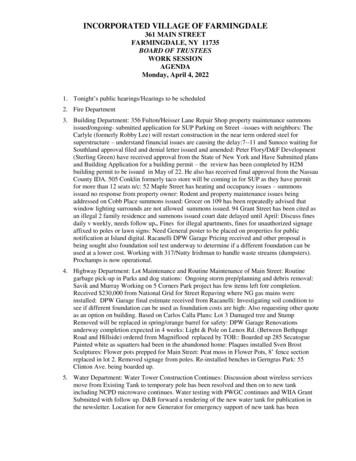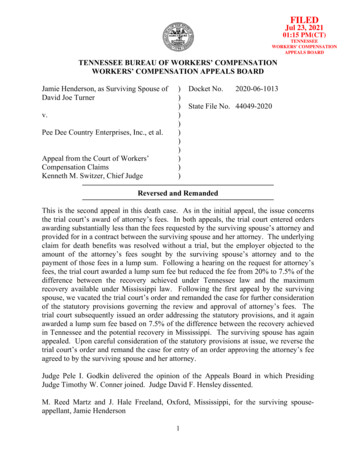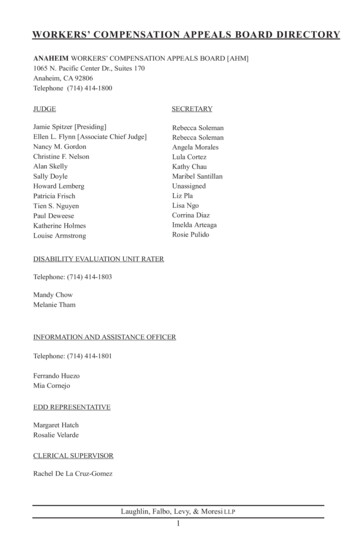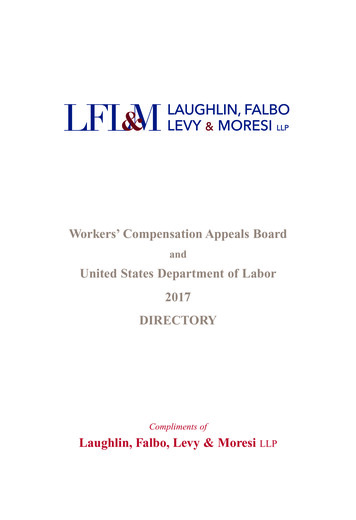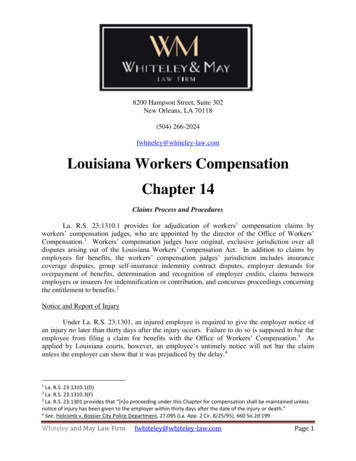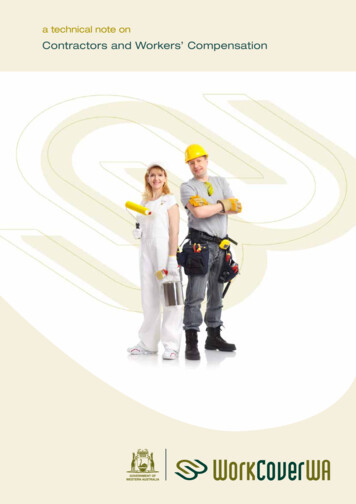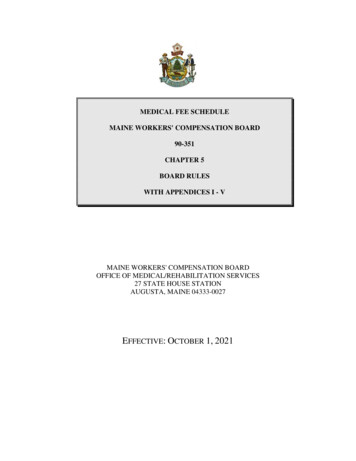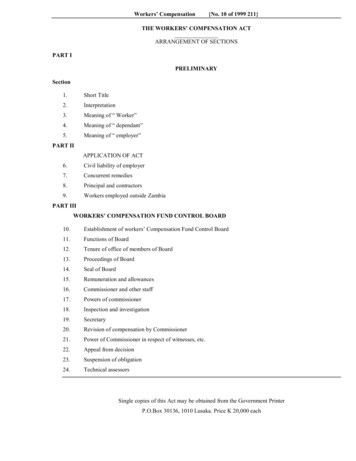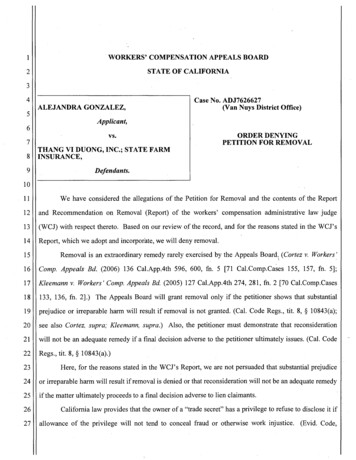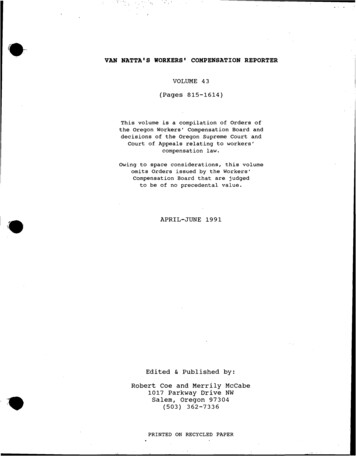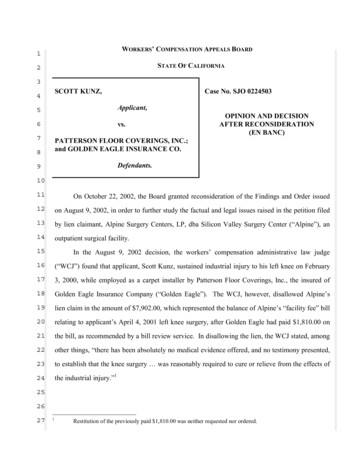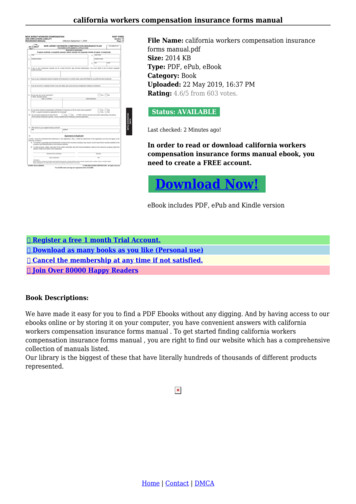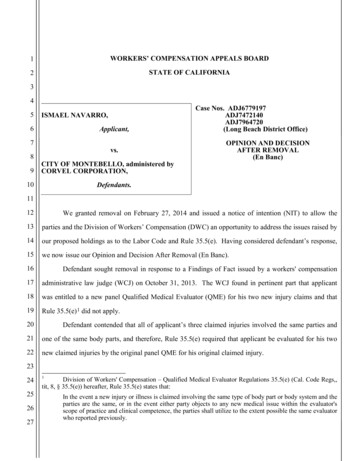
Transcription
1WORKERS’ COMPENSATION APPEALS BOARD2STATE OF CALIFORNIA345ISMAEL NAVARRO,6Applicant,789vs.CITY OF MONTEBELLO, administered byCORVEL CORPORATION,10Case Nos. ADJ6779197ADJ7472140ADJ7964720(Long Beach District Office)OPINION AND DECISIONAFTER REMOVAL(En Banc)Defendants.1112We granted removal on February 27, 2014 and issued a notice of intention (NIT) to allow the13parties and the Division of Workers’ Compensation (DWC) an opportunity to address the issues raised by14our proposed holdings as to the Labor Code and Rule 35.5(e). Having considered defendant’s response,15we now issue our Opinion and Decision After Removal (En Banc).16Defendant sought removal in response to a Findings of Fact issued by a workers' compensation17administrative law judge (WCJ) on October 31, 2013. The WCJ found in pertinent part that applicant18was entitled to a new panel Qualified Medical Evaluator (QME) for his two new injury claims and that19Rule 35.5(e) 1 did not apply.20Defendant contended that all of applicant’s three claimed injuries involved the same parties and21one of the same body parts, and therefore, Rule 35.5(e) required that applicant be evaluated for his two22new claimed injuries by the original panel QME for his original claimed injury.23242526271Division of Workers' Compensation – Qualified Medical Evaluator Regulations 35.5(e) (Cal. Code Regs,,tit, 8, § 35.5(e)) hereafter, Rule 35.5(e) states that:In the event a new injury or illness is claimed involving the same type of body part or body system and theparties are the same, or in the event either party objects to any new medical issue within the evaluator'sscope of practice and clinical competence, the parties shall utilize to the extent possible the same evaluatorwho reported previously.
1To secure uniformity of decision in the future, the Chairwoman of the Appeals Board, upon a2majority vote of its members, assigned this case to the Appeals Board as a whole for an en banc decision.3(Lab. Code, § 115.) 24Based upon our review of the relevant statutes and case law, we hold that:5(1)6panel QME for an evaluation of a subsequent claim of injury.7(2)8same evaluator when a new injury or illness is claimed involving the same9parties and the same type of body parts is inconsistent with the Labor10The requirement in Rule 35.5(e) that an employee return to theCode, and therefore, this requirement is invalid. 31112The Labor Code does not require an employee to return to the sameAs our decision after removal (en banc), we affirm the Findings of Fact and return the matter tothe trial level.13BACKGROUND14Applicant is employed as a police officer for defendant and all of his claims of injury were filed15during his employment with defendant. All of applicant’s claims of injury were filed while he was16represented by an attorney.17On February 12, 2009, applicant filed an application for adjudication with a Workers'18Compensation Claim Form DWC 1 (claim form) alleging a cumulative injury from February 9, 2008 to19February 9, 2009 to his back and ear (ADJ6779197). On September 14, 2009, applicant was evaluated20by panel QME J. Yogaratnam, M.D., in that case.21On October 4, 2010, applicant filed applications for adjudication with claim forms alleging a22specific injury of June 1, 2010 to his back, lower extremities and legs (ADJ7964720) and a specific23242526272En banc decisions of the Appeals Board are binding precedent on all Appeals Board panels and WCJs.(Cal. Code Regs., tit. 8, § 10341; City of Long Beach v. Workers’ Comp. Appeals Bd. (Garcia) (2005) 126Cal.App.4th 298, 313, fn. 5 [70 Cal.Comp.Cases 109]; Gee v. Workers’ Comp. Appeals Bd. (2002) 96 Cal.App.4th1418, 1425, fn. 6 [67 Cal.Comp.Cases 236]; see Govt. Code, § 11425.60(b).) In addition to being adopted as aprecedent decision in accordance with Labor Code section 115 and Appeals Board Rule 10341, this en bancdecision is also being adopted as a precedent decision in accordance with Government Code section 11425.60(b).3Unless otherwise stated, all statutory references are to the Labor Code.NAVARRO, Ismael2
1injury of August 31, 2010 to his back and left leg (ADJ7472140). 42On November 20, 2012, defendant petitioned to compel an evaluation of applicant’s two3subsequent claims of injury by original panel QME Dr. Yogaratnam, but it did not seek to have applicant4reevaluated regarding his previous claim of cumulative injury. Applicant objected on November 28,52012. On May 23, 2013, the parties proceeded to trial on the issue of whether applicant must return to6original panel QME Dr. Yogaratnam for his subsequent specific injury claims; the issue was ultimately7submitted for decision on August 20, 2013.89On October 31, 2013, the WCJ found in pertinent part that applicant was entitled to a new panelQME in his specific injury cases and that Rule 35.5(e) did not apply.10Thereafter, defendant timely filed its petition for removal.We received an Answer from11applicant. The WCJ prepared a Report and Recommendation (Report) recommending that removal be12denied.13In our NIT, the parties and DWC were given twenty days to respond.5In pertinent part, our NIT14ordered that responses were to be filed at the Office of the Commissioners, and not at a district office,15and that misfiled responses would not be accepted or considered. Yet, defendant filed its response on16March 21, 2014 at the San Francisco District Office. On March 24, 2014, the last day that a response17could be timely filed, defendant’s response was brought to our attention. Although defendant misfiled its18response, the response was received in the Office of the Commissioners within the time allowed and we19accept it and consider it.20In its response to our NIT, defendant contends that Rule 35.5(e) follows the Labor Code. In21support of its argument, it cites sections 4062.3(j), 4062.3(k), and 4067, all sections which concern a22single claim form and not subsequent claims of injury. It also cites Frink v. Shasta-Tehama-Trinity Joint23Community College 2012 Cal.Wrk.Comp. P.D. LEXIS 67 and McDuffie v. Los Angeles County242526274The Employer’s Section on the lower half of all three of the claim forms is blank. There is no informationin the record regarding whether any other claim forms were received by or completed by defendant. Each claimform was served on defendant at the time it was filed at the Workers’ Compensation Appeals Board (WCAB).5We did not receive a response from DWC.NAVARRO, Ismael3
1Metropolitan Transit Authority (2002) 67 Cal. Comp. Cases 138 (en banc), cases which involve a single2cumulative injury.345DISCUSSIONI.The Labor Code does not require an employee to return to the same QME for anevaluation of a subsequent claim of injury.6Defendant contended that Rule 35.5(e) applies and because Rule 35.5(e) applies, applicant must7return to original panel QME Dr. Yogaratnam. However, even though the sole basis of defendant’s8argument is that Rule 35.5(e) applies, we consider the relevant statutory provisions before we consider9the application of Rule 35.5(e).10“A fundamental rule of statutory construction is that a court should ascertain the intent of the11Legislature so as to effectuate the purpose of the law.” (DuBois v. Workers’ Comp. Appeals Bd. (1993) 512Cal.4th 382, 387 [58 Cal.Comp.Cases 286] (DuBois); Nickelsberg v. Workers’ Comp. Appeals Bd. (1991)1354 Cal.3d 288, 294 [56 Cal.Comp.Cases 476]; Moyer v. Workmen’s Comp. Appeals Bd. (1973) 10 Cal.3d14222, 230 [38 Cal. Comp. Cases 652].) “In construing a statute, our first task is to look to the language of15the statute itself. (citation) When the language is clear and there is no uncertainty as to the legislative16intent, we look no further and simply enforce the statute according to its terms.” (DuBois, supra, 517Cal.4th at p. 387; accord, Atlantic Richfield Co. v. Workers’ Comp. Appeals Bd. (Arvizu) (1982) 3118Cal.3d 715, 726 [47 Cal. Comp. Cases 500]; see Code Civ. Proc., §§ 1858, 1859; Rhiner v. Workers’19Comp. Appeals Bd. (1993) 4 Cal.4th 1213, 1217 [58 Cal.Comp.Cases 172].) Hence, we begin by20reviewing the language of the Labor Code sections on medical-legal evaluations by panel QMEs.212223242526Section 4060(a) provides in pertinent part that “this section shall apply to disputes over thecompensability of any injury. . .”Section 4060(c) states that:If a medical evaluation is required to determine compensability at any timeafter the filing of the claim form, and the employee is represented by anattorney, a medical evaluation to determine compensability shall beobtained only by the procedure provided in Section 4062.2. (Italics added.)27NAVARRO, Ismael4
1Section 4060(d) states that:2If a medical evaluation is required to determine compensability at any timeafter the claim form is filed, and the employee is not represented by anattorney, the employer shall provide the employee with notice either thatthe employer requests a comprehensive medical evaluation to determinecompensability or that the employer has not accepted liability and theemployee may request a comprehensive medical evaluation to determinecompensability. Either party may request a comprehensive medicalevaluation to determine compensability. The evaluation shall be obtainedonly by the procedure provided in Section 4062.1. (Italics added.)34567Section 4062.2(a) states that:8Whenever a comprehensive medical evaluation is required to resolve anydispute arising out of an injury or a claimed injury occurring on or afterJanuary 1, 2005, and the employee is represented by an attorney, theevaluation shall be obtained only as provided in this section. (Italicsadded.)91011Preliminarily then, section 4060(a), (c) and (d) and section 4062.2(a) 6 all refer to a single claim12form, injury or claimed injury and require that any medical-legal evaluations to determine compensability13of that injury or claimed injury occur under the procedures provided in sections 4062.1 or 4062.2.14Section 4062.3(j) states that:15Upon completing a determination of the disputed medical issue, themedical evaluator shall summarize the medical findings on a formprescribed by the administrative director and shall serve the formalmedical evaluation and the summary form on the employee and theemployer. The medical evaluation shall address all contested medicalissues arising from all injuries reported on one or more claim forms priorto the date of the employee's initial appointment with the medicalevaluator. (Italics and underscoring added.)1617181920Section 4064(a) states that:21The employer shall be liable for the cost of each reasonable and necessarycomprehensive medical-legal evaluation obtained by the employeepursuant to Sections 4060, 4061, and 4062. Each comprehensive medicallegal evaluation shall address all contested medical issues arising from allinjuries reported on one or more claim forms, except medical treatmentrecommendations, which are subject to utilization review as provided bySection 4610, and objections to utilization review determinations, which2223242526276Unlike section 4062.2, section 4062.1 does not contain a subdivision like section 4062.2(a) forunrepresented employees, but sections 4060(a) and (d) and section 4061(i) all specify that section 4062.1 appliesto unrepresented employees.NAVARRO, Ismael5
1are subject to independent medical review as provided by Section 4610.5.(Italics and underscoring added.)23Considering section 4062.3(j) and section 4064(a) together, both sections state that a medical4evaluation shall address “all medical issues arising from all injuries reported on one or more claim5forms.” 7 Both sections refer to an injury reported on a claim form as the operative act, and not to a date6of injury, a report of injury other than on a claim form 8, or the filing of an application with the WCAB.7Under section 5401, an employer must provide a claim form and an injured worker must file a claim form8with an employer. 9 Hence, the reported date under sections 4062.3(j) and 4064(a) must be the filing date9as defined by section 5401 because only section 5401 refers to filing a claim form. Because the date the10claim form is filed with employer is the operative act, the date of filing of the claim form determines11which evaluator must consider which injury claim(s). This is significant in that the date a claim of injury12is reported is often not the same as the date that an injury is claimed to have occurred. Consequently, it13is foreseeable that a claim might be reported after an original evaluation, but be for a claim of injury on a14date before the original evaluation, and even in those circumstances, the result would be that the date the15claim is reported is still the operative date.16Next, section 4062.3(k) states that:17If, after a medical evaluation is prepared, the employer or the employeesubsequently objects to any new medical issue, the parties, to the extentpossible, shall utilize the same medical evaluator who prepared theprevious evaluation to resolve the medical dispute. (Italics added.)181920212223242526277Although section 4064(a) does not include the phrase “before the appointment takes place,” since section4064(a) provides that these claims of injury had to have been “reported,” those claims had to have been madebefore the evaluation.8Section 5400 concerns notice of injury with no reference to a claim form. Section 5402 concerns noticeand knowledge of injury and section 5402(b) provides for a ninety day period after “the date the claim form is filedunder [s]ection 5401.”9Section 5401(a) requires that an employer must provide a claim form “[w]ithin one working day ofreceiving notice or knowledge of injury under [s]ection 5400 or 5402.” Section 5401(c) states that:“The completed claim form shall be filed with the employer by the injured employee, or, in the case ofdeath, by a dependent of the injured employee, or by an agent of the employee or dependent. . . .[A] claimform is deemed filed when it is personally delivered to the employer or received by the employer by firstclass or certified mail. A dated copy of the completed form shall be provided by the employer to theemployer's insurer and to the employee, dependent, or agent who filed the claim form.”NAVARRO, Ismael6
1As discussed above, sections 4062.3(j) and 4064(a) provide that a medical evaluation shall2address “all medical issues arising from all injuries reported on one or more claim forms,” and in keeping3with that statutory language, section 4062.3(k) directs an employee to return to the same evaluator who4conducted the previous evaluation when a new medical issue arises relating to the previously reported5injury claim(s). As a matter of construction, a prior evaluation of that previously reported injury claim(s)6must have already occurred at the time the medical issue arises, and consequently, the employee must7then return to the same evaluator for the same reported injury claim(s). 10 In contrast, there is no8reference in section 4062.3(k) to subsequent claims of injury.9Finally, section 4067 states that:10If the jurisdiction of the appeals board is invoked pursuant to Section 5803upon the grounds that the effects of the injury have recurred, increased,diminished, or terminated, a formal medical evaluation shall be obtainedpursuant to this article.1112“When an agreed medical evaluator or a qualified medical evaluatorselected by an unrepresented employee from a three-member panel haspreviously made a formal medical evaluation of the same or similar issues,the subsequent or additional formal medical evaluation shall be conductedby the same agreed medical evaluator or qualified medical evaluator,unless the workers' compensation judge has made a finding that he or shedid not rely on the prior evaluator's formal medical evaluation, any partycontested the original medical evaluation by filing an application foradjudication, the unrepresented employee hired an attorney and selected aqualified medical evaluator to conduct another evaluation pursuant tosubdivision (b) of Section 4064, or the prior evaluator is no longerqualified or readily available to prepare a formal medical evaluation, inwhich case Sections 4061 or 4062, as the case may be, shall apply as ifthere had been no prior formal medical evaluation. (Italics added.)1314151617181920Section 4067 sets forth specific procedures governing the reopening of a claim, and like section214062.3(k), requires that an employee return to the same evaluator for new medical issues arising out of a22particular injury claim. Section 4067 also provides that under certain circumstances an employee does23not have to return to the same evaluator even when it is for an evaluation of the same claim of injury, and2425262710Similarly, section 4062(a) provides in pertinent part that when a party objects to a medical issue notcovered by sections 4060 or 4061 and not subject to section 4610, a medical evaluation must be obtained under theprocedures in sections 4061.1 and 4062.2. And, section 4062(a) only refers to medical issues and not tosubsequent claims of injury or body parts. In addition, section 4061(i) also requires that evaluations of permanentimpairment be obtained in accordance with sections 4061.1 and 4062.2.NAVARRO, Ismael7
1when that occurs, sections 4061 and 4062 apply “as if there had been no prior formal medical2evaluation.” Like section 4062.3(k), there is no reference in section 4067 to subsequent claims of injury.3Accordingly, after review of the pertinent statutes, we conclude that the Labor Code requires that4all medical-legal evaluations be obtained as set forth under sections 4062.1or 4062.2 and that the Labor5Code requires that an evaluator discuss all medical issues arising from all reported claims of injury at the6time of an evaluation. Further, we conclude that the Labor Code generally requires that an employee7return to the original evaluator when a new medical issue arises in the same claim of injury and when an8employee reopens the same claim. But, we see no provision in the Labor Code that requires an employee9to return to the same evaluator for a subsequent claim of injury.And, we see no provision that10distinguishes between procedures for evaluation of claims of injury based on the same or different body11parts. Thus, we conclude that the Labor Code does not require an employee to return to the same12evaluator for a subsequent claim of injury.13II.14The requirement in Rule 35.5(e) that an employee return to the same evaluator when anew injury or illness is claimed involving the same parties and the same type of bodyparts is inconsistent with the Labor Code, and therefore, this requirement is invalid.15We now consider Rule 35.5(e) in light of our conclusion that the Labor Code does not require an16employee to return to the same evaluator for a subsequent claim of injury. As discussed above, we17conclude that the Labor Code provisions concerning medical-legal evaluations only require the employee18to return to the same evaluator when a new medical issue arises out of a previously evaluated injury. In19contrast, Rule 35.5(e) imposes an additional requirement that an employee return to the same evaluator20when a new injury or illness is claimed that involves the same body parts and the same parties.21The WCAB has exclusive original jurisdiction to determine the validity of regulations adopted by22the Administrative Director (AD). (Lab. Code, § 5300(f); see Mendoza v. Huntington Hospital Workers'23Comp. Appeals Bd. (2010) 75 Cal.Comp.Cases 634, 640 (Appeals Board en banc) [discussing the24WCAB’s jurisdiction to determine the validity of Rule 30(d)(3)].)25In considering the validity of a regulation, “our task is to inquire into the legality of the . . .26regulation, not its wisdom.” (Moore v. Cal. State Bd. of Accountancy (1992) 2 Cal.4th 999, 1014; accord,27State Farm Mutual Automobile Ins. Co. v. Garamendi (2004) 32 Cal.4th 1029, 1040 (State Farm).)NAVARRO, Ismael8
1Thus, we are “limited to determining whether the regulation (1) is within the scope of the authority2conferred (Gov. Code, § 11373) and (2) is reasonably necessary to effectuate the purpose of the statute.”3(State Farm, 32 Cal.4th at p. 1040 [quoting from Agric. Labor Relations Bd. v. Superior Court (1976) 164Cal.3d 392, 411 (Agric. Labor Relations Bd.) (internal citations and quotation marks omitted)].)5“Although in determining whether . . . regulations are reasonably necessary to effectuate the statutory6purpose we will not intervene in the absence of an arbitrary or capricious decision, ‘we need not make7such a determination if the regulations transgress statutory power.’” (Cal. Assn. of Psychology Providers8v. Rank (1990) 51 Cal.3d 1, 11–12 (Cal. Assn. of Psychology Providers [quoting from Morris v. Williams9(1967) 67 Cal.2d 733, 749 (Morris) (italics added)].)10With regard to this latter point, we are guided by two of the central provisions of the11administrative rule-making provisions of the Administrative Procedures Act [APA] (Gov. Code, § 1134012et seq.), to which the AD is subject. 11 Government Code section 11342.2 provides that “no regulation13adopted is valid or effective unless consistent and not in conflict with the statute.” Hence, it has been14said that “[w]hen a statute confers upon a state agency the authority to adopt regulations . . . , the15agency's regulations must be consistent, not in conflict with the statute” (Mooney v. Pickett (1971) 416Cal.3d 669, 679) and that “[a] regulation that is inconsistent with the statute it seeks to implement is17invalid.” (Esberg v. Union Oil Co. (2002) 28 Cal.4th 262, 269.) “No matter how altruistic its motives, an18administrative agency has no discretion to promulgate a regulation that is inconsistent with the governing19statutes.” (Mendoza, supra, 75 Cal.Comp.Cases at p. 640; see Agric. Labor Relations Bd., supra, 1620Cal.3d at p. 419.) Government Code section 11342.1 provides that “[e]ach regulation adopted, to be21effective, shall be within the scope of authority conferred.” Thus, it has been said that “administrative22regulations which exceed the scope of the enabling statute are invalid and have no force or life” (Woods23v. Superior Court (1981) 28 Cal.3d 668, 680) and that “[a]dministrative regulations that . . . enlarge [a24statute's] scope are void and courts not only may, but it is their obligation to strike down such25262711The APA makes every regulation subject to its rulemaking provisions unless expressly exempted bystatute. (Gov. Code, § 11346.) By statute, DWC is exempted only from the APA's provision regarding SuperiorCourt review of agency regulations. (Gov. Code, § 11351(c).)NAVARRO, Ismael9
1regulations.” (Cal. Assn. of Psychology Providers, supra, 51 Cal.3d at p. 11 [quoting from Morris, supra,267 Cal.2d at p. 748].) “[T]he Legislature possesses the plenary constitutional authority to create and3enforce a workers’ compensation system” and accordingly, a regulation promulgated by the AD which4contradicts the Workers' Compensation Act is invalid. (Boehm & Associates v. Workers' Comp. Appeals5Bd. (Lopez) (1999) 76 Cal.App.4th 513, 519 [64 Cal.Comp.Cases 1350].)6As set forth in our discussion above, we conclude that the Labor Code requires that all medical-7legal evaluations be obtained as set forth under sections 4062.1 or 4062.2 and requires that an evaluator8discuss all medical issues arising from all reported claims of injury at the time of an evaluation. We also9conclude that the Labor Code generally requires that an employee return to the original evaluator when a10new medical issue arises in the same claim of injury and when an employee reopens the same claim.11But, the Labor Code makes no reference to same or different body parts. Therefore, unlike Rule 35.5(e),12the Labor Code does not require an employee to return to the original evaluator when another claim of13injury is filed even when the subsequent claim of injury involves the same body parts and the same14parties. The language of the statutes is mandatory, and thereby controls.15Rule 35.5(e) imposes an unwarranted limitation on the Labor Code, particularly sections 4060(a),16(c), and (d), 4062.1, 4062.2, 4062.2(a), 4062.3(j), 4062.3(k), 4064(a), and 4067. Thus, Rule 35.5(e) is17invalid to the extent that it imposes the additional requirement that an employee return to the same18evaluator when a new injury or illness is claimed that involves the same body parts and the same parties.19While parties are not precluded from agreeing to return to the same evaluator for subsequent claims of20injury, based on the foregoing, we conclude that an employee may be evaluated by a new evaluator for21each injury or injuries reported on a claim form after an evaluation has taken place. Thus, regardless of22whether a subsequent claim of injury is filed with the same employer or a different employer and23regardless of whether injury is claimed to the same body parts or to different body parts, when a24subsequent claim of injury is filed, the Labor Code allows the employee and/or the employer to request a25new evaluator. In keeping with the limitations set forth in sections 4062.3(j) and 4064(a), at the time of26an evaluation the evaluator shall consider all issues arising out of any claims that were reported before27NAVARRO, Ismael10
1the evaluation, and if several subsequent claims of injury are filed before the evaluation by the new2evaluator takes place, that one new evaluator shall consider all of those claims of injury.3We are aware that in a particular case it may be beneficial to one side to seek a new evaluator and4that unfortunately, a subsequent claim of injury could be filed by an employee or an employer with the5goal of “doctor-shopping,” potentially leading to increased medical-legal costs and delays. However,6since these provisions of the Labor Code apply equally to both employees and employers, we do not see7that either side gains an overall advantage. We also remind all participants that it is constitutionally8required that workers’ compensation proceedings be expeditious. (Cal. Const., art. XIV, § 4.)9Here, while we agree with the WCJ’s decision that applicant is entitled to a new panel QME, we10do not believe that the result turns on the application of Rule 35.5(e).11legal evaluation by Dr. Yogaratnam for his claimed cumulative injury and because applicant was12represented that evaluation necessarily would have been pursuant to section 4062.2. 12 Subsequently,13applicant reported two specific injury claims. 13 Even where, as here, an applicant’s three claimed14injuries involve some of the same body parts and the same parties, the statutes make no distinction15between claims or injuries to same or different body parts and same or different parties. Applicant’s two16claims of specific injury were reported after the original evaluation but before a subsequent evaluation by17a new evaluator. Thus, under sections 4062.3(j) and section 4064(a), applicant is entitled to be evaluated18by one new evaluator for his two subsequent claims of injury. Therefore, we conclude that applicant is19not required to return to Dr. Yogaratnam for an evaluation of his two subsequent claims of injury and20may be evaluated by a new panel QME.Applicant attended a medical-2122232425262712Although the case of an unrepresented applicant is not before us, it appears that the difference between anunrepresented and a represented applicant is whether section 4062.1 or 4062.2 applies. Accordingly, we do notbelieve that whether applicant was represented or unrepresented would change the outcome of this decision.13Here, there is nothing in the record to indicate whether applicant filed claim forms for his subsequentclaims of injury with his employer before he filed claim forms at the WCAB on October 4, 2010. However, theoriginal evaluation occurred on September 14, 2009, almost a year before the dates of the two subsequent claimedinjuries. Although the issue does not arise in the case before us, we point out that in other cases where multipleclaim forms were filed for the same date of injury, the date that the first of those multiple claim forms was filedcould be significant in determining which panel QME conducts an evaluation.NAVARRO, Ismael11
1Accordingly, based upon our review of the relevant statutes and case law, we hold that:2(1)3panel QME for an evaluation of a subsequent claim of injury.4(2)5same evaluator when a new injury or illness is claimed involving the same6parties and the same type of body parts is inconsistent with the Labor7Code, and therefore, this requirement is invalid.8The Labor Code does not require an employee to return to the sameThe requirement in Rule 35.5(e) that an employee return to theWe also affirm the Findings of Fact and return the matter to the trial NAVARRO, Ismael12
1For the foregoing reasons,2IT IS HEREBY ORDERED as the Decision After Removal of the Workers’ Compensation3Appeals Board (En Banc) that the Findings of Fact issued on October 31, 2013 is AFFIRMED and the4matter is RETURNED to the trial level.56WORKERS’ COMPENSATION APPEALS BOARD (EN BANC)78/s/ Ronnie G. CaplaneRONNIE G. CAPLANE, Chairwoman91011/s/ Frank M. BrassFRANK M. BRASS, Commissioner1213/s/ Deidra E. LoweDEIDRA E. LOWE, Commissioner141516/s/ Marguerite SweeneyMARGUERITE SWEENEY, Commissioner1718192021222324252627DATED AND FILED AT SAN FRANCISCO, CALIFORNIA4/2/2014SERVICE MADE ON THE ABOVE DATE ON THE PERSONS LISTED BELOW AT THEIRADDRESSES SHOWN ON THE CURRENT OFFICIAL ADDRESS RECORD.ISMAEL NAVARROACTING ADMINISTRATIVE DIRECTOR OVERPECKHITZKE & ASSOCIATES, ATTN: JEANNETTE Y. OROZCOLISTER, MARTIN & THOMPSON, LLP, ATTN: JONATHAN D. OGDENAS/jp/absNAVARRO, Ismael13
Workers' Comp. Appeals Bd. (1991) 54 Cal.3d 288, 294 [56 Cal.Comp.Cases 476]; Moyer v. Workmen's Comp. Appeals Bd. (1973) 10 Cal.3d 222, 230 [38 Cal. Comp. Cases 652].) "In construing a statute, our first task is to look to the language of the statute itself. (citation) When the language is clear and there is no uncertainty as to the .
